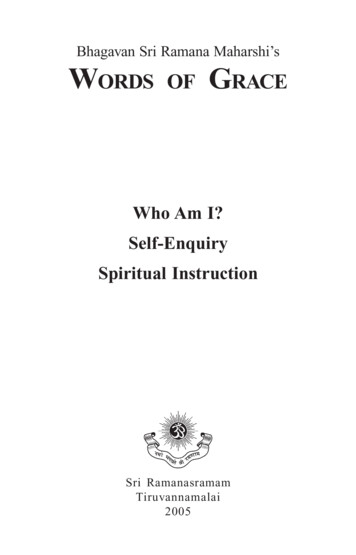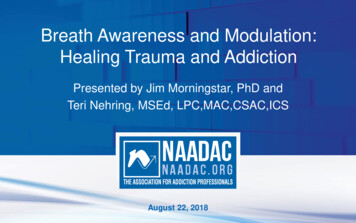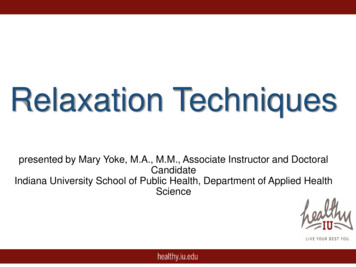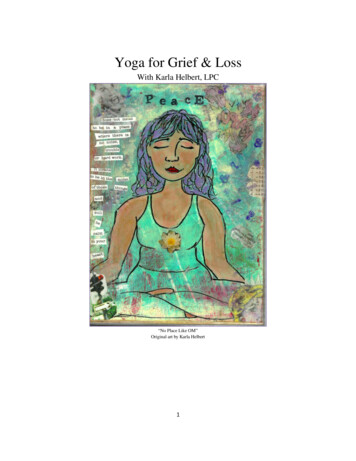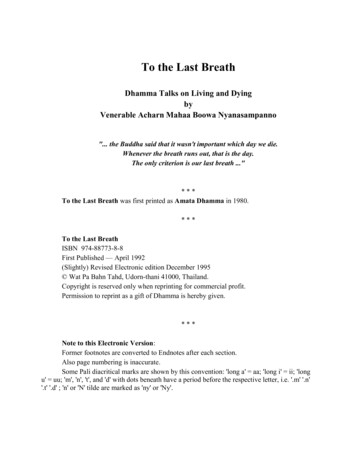
Transcription
To the Last BreathDhamma Talks on Living and DyingbyVenerable Acharn Mahaa Boowa Nyanasampanno". the Buddha said that it wasn't important which day we die.Whenever the breath runs out, that is the day.The only criterion is our last breath ."***To the Last Breath was first printed as Amata Dhamma in 1980.***To the Last BreathISBN 974-88773-8-8First Published — April 1992(Slightly) Revised Electronic edition December 1995 Wat Pa Bahn Tahd, Udorn-thani 41000, Thailand.Copyright is reserved only when reprinting for commercial profit.Permission to reprint as a gift of Dhamma is hereby given.***Note to this Electronic Version:Former footnotes are converted to Endnotes after each section.Also page numbering is inaccurate.Some Pali diacritical marks are shown by this convention: 'long a' aa; 'long i' ii; 'longu' uu; 'm', 'n', 't', and 'd' with dots beneath have a period before the respective letter, i.e. '.m' '.n''.t' '.d' ; 'n' or 'N' tilde are marked as 'ny' or 'Ny'.
Editor's PrefaceThis book contains two sets of newly revised Dhamma talks. The 1980 edition of AmataDhamma has been completely revised and has new additions, including its new title, To the LastBreath.As Acharn Panyavaddho explained in the introduction he wrote for the 1980 AmataDhamma: "(six) of these (seven) talks were given for the benefit of Mrs. Pow-panga Vathanakul,who had been staying in Wat Pa Bahn Tahd, Udorn-thani, Thailand, since the beginning ofNovember 1975. The other talk, The Middle Way (of Practice), was actually given to theassembly of bhikkhus at the Wat in 1962, and was one which Mrs. Pow-panga found useful. .She stayed at Wat Pa Bahn Tahd for almost four months and Ven. Acharn Maha Boowa gaveabout 130 talks during that period."(1)The first translation of To the Last Breath (or Amata Dhamma as it was then) was mainlythe work of Ven. Bhikkhu A-j-. The present editor, who also assisted at that time, has nowcompletely revised the whole translation and so must bear responsibility for the errors.Any merit arising from my work on this book, may it be dedicated to my mother. May shefind peace and happiness.A. Bhikkhu***Table of Contents [Page numbers are not accurate in this electronic version]Editor's PrefaceIntroductioniiiviTo the Last Breath1Biographical Note2Ready to Go : Ready to Die 3The Undying 11The Highest Blessing 19The Internal and the External — The True and the FalseLetting Go36The Final Night — Fare Thee Well 43The Middle WayEpilogue615027
***IntroductionAnyone who has visited the forest monasteries of Thailand will need no introduction. They willhave seen Acharns(1) who teach in a spontaneous and direct way, and who live as they teach.This is Forest Dhamma, vigorous but without pretension, inspiring one to live and practise theWay rather than reading about it. Yet here is a book — and a translation of a book at that — thatcan only attempt to offer a partial view of certain aspects of that Teaching.This is especially so with the first part of this collection of Dhamma talks, To the Last Breath.For these were given under quite special circumstances: A person, quite knowledgeable aboutBuddhism, is dying of cancer. The emphasis is therefore very much on dealing with pain,suffering and, finally, death. And pointing towards that which is beyond suffering and death.These circumstances mean that the beginning fundamentals of Dhamma practice are generallyassumed to be already understood. (Khun Pow and the other listeners were already well practisedin developing Dhamma in their actions and speech.)(2) For those new to Dhamma, however, it isimportant to remember the special context and to take into account the other Dhamma qualitiesthat make an essential foundation that will need to be cultivated. The Lord Buddha gave animportant example of this when he would begin his Dhamma Teaching (to those newlyinterested) with the Progressive or Graduated Sermon:"Then the Lord delivered a graduated discourse to 'Kutadanta,' on generosity, onmorality and on heaven, showing the danger, degradation and corruption ofsense-desires, and the profit of renunciation. And when the Lord knew thatKutadanta's mind was ready, pliable, free from the hindrances, joyful and calm,then he preached a sermon on Dhamma in brief: on suffering, its origin, itscessation, and the path. . ."It is this 'joyful, calm, pliable, ready mind' — already settled firmly upon foundations ofgenerosity and morality — that is receptive to the powerful Truths about pain, suffering anddeath. It is at this point that the emphasis changes to energetic striving, to overcoming theobstacles that prevent insight and pin us blindly to the wheel of birth and death."Then the Lord said to the monks: 'Now, monks, I declare to you: all conditionedthings are of a nature to decay — strive on untiringly.' These were the Tathagata'slast words."In this book you will find both these aspects. There are constant references to 'gradually' .'steadily' . 'step by step' . 'level by level' (of the Graduated Teaching). These lead into agrowing emphasis on earnestness and diligence in practice.Any translation is the impossible search for just the right word. The expression that conveys boththe sense and accuracy in a pleasing way; and that also brings with it the spirit of the original.This translation is much more of a blind groping. First, there is the wide language and culturalgap between Thai and English. Then there is the change of medium from the living word to theprinted page, which must always lose the dynamism of the original experience. Finally, andperhaps the most important point, there is the great profundity of Dhamma, which is reallybeyond the translators' level of understanding. The reader will therefore need to make dueallowance for the deficiencies in this translation effort. The only way truly to understand is totranslate it back into your own life, your own experience and practice.Even with its errors and inadequacies this book is the result of a great effort by many people. It
will have all been worth while if a single person finds some truth in it that can help him or herface up to their situation, their illness and pain. Insight into that suffering may they go beyond amere book's description to true liberation.***(1) Meditation Teachers.(2) See Epilogue.(3) Anupubbikatha. Also see the Appendix.(4) Thus Have I Heard. Page 141/29. (D.i.148) (Maurice Walshe, trans. ; London:Wisdom Publications, 1987.)(5) ibid., p. 270/67. (D.ii.156).(6) To help with these points, Pali terms have been kept to a minimum or put inthe Glossary. Repetitions — which spoken Thai delights in with its musicalvariations of words and phrases; and which also serve to reinforce the Dhammathemes — have sometimes been deleted.To the Last BreathDhamma Talks on Living and DyingbyVenerable Acharn Mahaa Boowa NyanasampannoofWat Pa Bahn TahdUdorn-thani, N.E. ThailandBiographical NoteVenerable Acharn Maha Boowa was born in Udorn-thani, North-east Thailand in1913. He became a monk in the customary way at a local monastery and went onto study the Pali language and texts. At this time he also started to meditate buthad not yet found a suitable Teacher. Then he caught sight of the Ven. AcharnMun and immediately felt that this was someone really special, someone whoobviously had achieved something from his Dhamma practice.After finishing his Grade Three Pali studies(1) he therefore left the studymonastery and followed Ven. Acharn Mun into the forests of N.E. Thailand.When he caught up with Ven. Acharn Mun, he was told to put his academicknowledge to one side and concentrate on meditation. And that was what he did.He often went into solitary retreat in the mountains and jungle but always returned
for help and advice from Ven. Acharn Mun. He stayed with Ven. Acharn Mun forseven years, right until the Ven. Acharn's passing away.The vigour and uncompromising determination of his Dhamma practice attractedother monks dedicated to meditation and this eventually resulted in the foundingof Wat Pa Bahn Tahd, in some forest near the village where he was born. Thisenabled his mother to come and live as a nun at the monastery.Ven. Acharn Maha Boowa is well known for the fluency and skill of his Dhammatalks, and their direct and dynamic approach. They obviously reflect his ownattitude and the way he personally practised Dhamma. This is best exemplified inthe Dhamma talks he gives to those who go to meditate at Wat Pa Bahn Tahd.Such talks usually take place in the cool of the evening, with lamps lit and theonly sound being the insects and cicadas in the surrounding jungle. He oftenbegins the Dhamma talk with a few moments of stillness — this is the mostpreparation he needs — and then quietly begins the Dhamma exposition. As thetheme naturally develops, the pace quickens and those listening increasingly feelits strength and depth.The formal Dhamma talk might last from thirty-five to sixty minutes. Then, after amore general talk, the listeners would all go back to their solitary huts in thejungle to continue the practice, to try to find the Dhamma they had been listeningabout — inside themselves.*(1) On completion of Grade Three Paali, one is given the title Mahaa. There arenine grades in all.1Ready to Go : Ready to DieThis heart of ours is much like a child. The child is unable to take care of itself and so has todepend on mother and father, on guardians and nursemaids, holding on to various people. But thechild at least has parents and guardians to look after it, to make sure it seldom meets with harm.Whereas although the heart is always grasping and clinging to various things, it doesn't find anysuch safety and security.The heart can't rely on itself and therefore always likes to cling onto things. For the most part, ittends to reach for wrong things, for things that do it harm. The reason it likes to search for andhold on to things, is so that it can find safety, security and comfort for itself. The things it clingsto however, are not dependable and so they pose a constant danger for the heart. Whether we arechildren or already grown up, this is the way our minds tend to be.Instead of trying to rely on ourselves we always put our hopes in other things, other people. Wecan't stand on own two feet. This is because the heart isn't wise enough to check whether theobjects it grasps hold of are right or wrong, good or bad. It doesn't know how to care for itself,how to help itself, because there's no one to teach it. There's nobody to advise on how to knowwhich things are dangerous and which are beneficial, which things should be held on to andwhich things shouldn't. The heart therefore continues indiscriminately to grasp hold of anything,whether good or bad, as long as it likes the look of it. Even if it isn't gratifying, the heart'scharacteristic trait is still to keep on grasping and clinging. Why should it be like this?
Normally, one wouldn't think that a mood(1) or a thing that's displeasing is worth clinging to. Yetthe heart continues to grasp hold of such things. It clings to anger, to delusion and lust, hatred anddisgust, because it becomes involved and caught up in them. We can never say that the heartsimply knows an object, for it always gets caught up in it and clings to it. For the most part, thosethings have nothing good in them.Why does the heart have to go and grasp at things? It's because it is attracted without realizing therepercussions of its attachment. Even though you may wish to break away from it you can't,because there's something else which is powerful enough to force the heart to grasp and hang on.The object then becomes caught up in emotions, which continually overcloud and obscureyourself. Here we're talking about emotional objects1 and moods.Now I'll speak about material objects. The heart will grasp at and cling to whatever object ispresent. It doesn't matter how trifling or significant, how valuable or worthless it might be; theheart can and will attach itself. We wouldn't be wrong if we were to call the heart an expert'hanger-on'. This is because it's still unable to rely on itself, and so must depend on outside things,until the end of the body that has led one through the changing situations. It may even forgetitself by surrendering to the power of external objects, even though their control is baseless andleads the wrong way.The Lord Buddha taught that, "self is the protector of self".(2) Try to cure the heart of itsdependency, of the tendency it has of always hoping to rely on other things. Disengage yourselffrom such objects and turn inward to rely more on your own resources and abilities. Don't dependon your parents, friends and others, so much that you forget yourself. Our human trait ofcontinually seeking support in other people develops eventually into a personal habit. It's like thisall over the world, and in this regard we can hardly even measure up to some kinds of animals.This, then, is why the Lord Buddha taught about self-reliance.In our commonplace and coarse affairs, like work and other such responsibilities, we should tryto be more self-reliant. Coming in towards Dhamma — the practice of meditation in the heart —we need to have had sufficient training under a Teacher to know the right direction in which toproceed. The actual practice though, is the duty of each one of us, to find assurance in our selfreliance following the principles of Dhamma. The Lord Buddha taught, for example, aboutcultivating goodness and virtue through generosity, precepts(3) and meditation. This is so that wecan develop self-reliance, which is the heart firmly holding to good and wholesome objects.There is then peace and happiness in both the present and future lives, because they are beneficialthings and originate from wholesome actions. They make up fine objects or superior quality foodfor the heart.We are taught to meditate, which is a step higher in refinement. This effort to train ourselves inmeditation is a way of self-reliance that is steadily taken onto a firmer and more dependablelevel. We use a meditation-word(4) as the means to direct and control the heart. For, as the mindis not yet able to sustain itself, we have to rely on the meditation-word as the object to soothe andbring peace and calm. The settling of the mind in "buddho buddho buddho ." is one example ofthis. It is an object for the heart to occupy itself with, which is correct and right and appropriate tofinding refuge in Dhamma.In the beginning of the practice the heart is still restless and distracted, still unable to settle itselfon Dhamma principles and become self-reliant. It has to depend on a meditation-word to direct ituntil it merges in with that meditation-word and gathers into stillness. When it enters calm, eventhe meditation-word itself ceases to be an issue. This is one step towards self-reliance for themeditation-word can be released at this stage, as the heart is well settled in calm. This is afoundation and refuge for the heart that can be clearly seen. Even with just this much, there'scalm and ease in the heart that used to be restless and distracted, unable to find any peace. This isbecause the heart normally does not know peace but only trouble and unrest, hunger and thirst,
worries and concerns over affairs that are of no use to it at all. For the most part these affairs arethe heart's own thoughts and imaginings, which poison and burn oneself — without anyone elsebeing involved.The Lord Buddha discovered the correct way to practise and achieved results to his heart'scontentment. He was therefore able to explain about the causes, or the way to practise, togetherwith their fulfilment and fruits. He taught us that the way to depend on oneself is throughmeditation and that this is the direct route to a firmly established self-reliance. Basing the heart incalm, to whatever degree, brings increasingly self-assurance and confidence — without having toask anyone else about it. You will know from within yourself. This is termed paccata.m orsandi.t.thiko. The knowledge of good or bad, what needs remedying, removing or developing,will then arise in the heart. This will be understood by oneself and for oneself, as the heart ismore and more firmly established.The level of concentration, once reached, is already sufficient to form a foundation for the heart,a home where the heart can find shelter and peace. At the moment when we think so much thatwe feel faint-hearted and weary, we should turn inwards and meditate. The heart can then restand be stilled from all its preoccupations, finding peace and calm. This is called going inward forrefuge, to find a resting place of comfort and ease. This is one level of refuge for the heart.The next steps, even though they're still concerned with samadhi, are proceeding into more subtleand refined aspects of the heart. The levels of momentary concentration, access concentrationand attainment concentration(5) show the refining of samadhi. This culminates in attainmentconcentration, and beyond that samadhi can't advance.Once the heart has some degree of calm, according to the level of samadhi achieved, it is stilledand refined. However, without developing mindfulness and wisdom(6) it will just remain at thatlevel, lacking wisdom radically to uproot its defilements.(7) If we compare the defilements to atree, although we may have pruned the branches the main trunk remains uncut and is still capableof sending out new branches.This is why we're taught to investigate by way of wisdom. Wisdom is a keen intelligence andingenuity. It is able to investigate and follow through without any limitation. The Lord Buddhadescribed wisdom-and-knowledge — being even more refined than wisdom — in the Discourseof Setting the Wheel of Dhamma in Motion. Listen to this:"Nyaa.na.m udapaadi, panyaa udapaadi, vijjaa udapaadi, aaloko udapaadi.""Knowledge arose, wisdom arose, higher-knowledge arose, light arose."Knowledge or vijjaa refers basically to the Threefold Knowledge.(8) Wisdom arose, and, withgreater refinement, higher- knowledge arose — arising right from this same heart. Wisdom is thatwhich removes the defilements covering the heart, whereas samadhi is simply that which herdsthe defilements together in quietness within the heart. It is not yet capable of cutting off anydefilements. The heart's attachment, which embroils it with various things, remains intact thoughit's weakening. Once the heart gains some calm and peace, wisdom can come into its own as theimportant weapon that strikes down and uproots all the different defilements in the heart, step bystep."Samaadhi-paribhaavitaa panyaa mahapphalaa hoti mahaanisa.msaa."There! "Wisdom once supported and nurtured in samadhi, is of great fruit andgreat advantage." Its examination becomes skilled, its scrutiny agile and bold, sothat it is able to cut away the defilements one after another."Panyaa-paribhaavita.m citta.m sammadeva aasavehi vimuccati.""The heart nurtured with wisdom gains proper release from the cankers."Listen to that! It's wisdom alone that can uproot the defilements; it doesn't matter whether they
are gross, intermediate or subtle, no defilement lies beyond the scope of wisdom. This is aprimary principle that secures the quality and value of our practice, which is the total eliminationof the defilements from the heart. It's the same practice which the Lord Buddha and his NobleDisciples have already completed before us.Thus samadhi and wisdom can't be separated from each other. Whatever our character andtendencies might be, samadhi is always needed as a quiet resting place for the heart. The heartrests from work, by stilling in samadhi its thoughts and preoccupations. Even work in the worldrequires a period of rest and recuperation — making do without is just not possible. This maycertainly use up working-time but, just as eating uses up food and the money needed to buy thatfood, it is necessary that the body has renewed vigour to continue its work. Resting and sleepingmay waste some time but, again, they give the constitution new strength to fulfil its duties andtasks. Otherwise it won't be able to go on.This use of time and material to provide for and restrengthen the body is certainly not wasted.Rather, they act like fuel for a car, which won't go anywhere without it. Samadhi and wisdomhave the same sort of relationship. The mind needs time to be still and calm in samadhi, and, afterit has rested, it can then continue its investigation using mindfulness and wisdom in line with itsabilities.This word wisdom describes something very subtle and broad ranging, to accord with thecharacter and tendencies of the person bringing it into use. Any approach we use to investigatefor the sake of uprooting the defilements is termed right wisdom.It's not necessary always to have to go and read the scriptures in order to know how to deal withthe defilements; and in order for it to be 'Dhamma'. These texts were extracted from the heart thatis Dhamma, which had actually performed the uprooting of the defilements and clearly seen thefruits. Only then was it written down in the scriptures. So it's not the case that the texts originatedbefore the Truth — which is the actual practice.The Lord Buddha was the first to practice and so no scriptures had been made for him to use.When he taught his disciples the Noble Truths, he didn't write them down in palm leaf texts. Hetaught them by word of mouth, and then his disciples themselves carried on the Teaching throughword of mouth. Where did they get their teachings? — From the reality in their hearts, whichthey had seen clearly as a result of their own practice.It is for this reason that the techniques and strategies of mindfulness and wisdom dependprimarily on the individual. Each of us needs to think, examine, investigate and work outstrategies using our own intelligence and abilities, according to each case. Therefore, there's noneed always to go back to retrieve scriptural authority with questions like: "I've thought this upmyself so it can't possibly deal with the defilements." This way of thinking is not in accord withthe principles of Dhamma and can't be called right wisdom. When those things we rememberfrom the scriptures can't be actualized in ridding our heart of any defilements then this too, for us,isn't right wisdom. It may be right wisdom in the scriptures but it's wrong in the way it's used.The Dhamma is only explained to a limited extent in the scriptures. It's not really all that much. Ifwe compare it to a medicine, it's a general nonspecific remedy rather than one aimed at aparticular illness. Our integrating and formulating a specific approach capable of dealing witheach particular defilement is termed medicine. It is a remedy aimed at steadily uprooting a certaindefilement. This is why those who are successfully practising in the way of wisdom haveDhamma, have mindfulness and wisdom with them wherever they are.Ven. Acharn Mun once said that he "listened to Dhamma day and night". Just think of that!Things keep making contact with our senses of sight, hearing, smell, taste, and touch at all times.If the knowledge of this contact doesn't arise at the heart, which is waiting with acknowledgment,where else is it going to occur? What is it that acknowledges? The heart's acknowledging also
stirs up mindfulness and wisdom, which must come in to examine the ongoing involvement witha well-founded scrutiny, that accords with cause and effect. It checks out the contact and when itknows, it is able progressively to withdraw or let go. This is what is called, 'listening to Dhammaday and night', listening to Dhamma in the primal principles of nature. Defilements are naturalprinciples together with the heart. Dhamma, with its virtue, samadhi and wisdom are naturalprinciples within the heart. It all depends on how we bring them out to use in our investigating;utilizing them to full advantage according to the ability of mindfulness and wisdom, which is theideal instrument to use.The body. Listen! Elements, aggregates, body. The Lord Buddha had them and all his discipleshave had them. At one stage they seized hold and attached to those aggregates, just as we do now.Such defilements were the same for them as they are now for us. But by grasping and attachingto, we establish conditions and causes for the accumulation of defilement in our hearts.The Lord Buddha and his arahant disciples formerly had defilements — just like us now — sowhy was it possible for them to uproot them? The body is the same, the five aggregates are thesame, yet they could release their attachment whereas we can't. Why? We don't seem able tounderstand, yet how was it that they were able to gain realization? Why can't we alsocomprehend? The heart is present, and mindfulness and wisdom can be built up in each aspect,according to whatever angle we wish to take up for examination.This body, which exists right with us here now, is something that can be known and understood.When we say that the heart can't depend on itself, what it all comes down to is that it needs todepend on the body. Moreover, it not only relies on the aggregates but also holds to them asbeing self. There! We depend on them and unashamedly uphold them as self. What about thatthen? Even with some measure of shame, they inevitably must be held onto becausecomprehension is still lacking, and without it any possibility of letting-go. So, it is quite correctto say that we've been shameless and we need to admit to our stupidity. From here, we mustendeavour to develop some cleverness that will see these things and let go of them through thestrength of our own efforts.So, for once, let's get down to the facts. These things follow the principles of nature and remainas they are they, whereas we exert ourselves to pull them in as our-self. Now that is going tomake problems because it goes against the truth of things. To be in line with the facts you have toinvestigate to see according to the truth about them. Repeatedly examine and keep oninvestigating until you can understand. Once you understand, you won't have to order the mind tolet go. It will let go on its own because these things are poisonous and harmful to us, owing to ourown attachment. There are certainly no benefits in this attachment. If there were any merit oradvantage, the Lord Buddha would have told us to grasp hold — but then, such advice would notbe needed as the heart would have already involved itself. It is that attachment that is the trulypoisonous and harmful thing.Even though those things may be dangerous to us, we still seize and bring them close in. We holdthem by making the assumptions that, I'm like this, I'm like that; they are me; they are mine. Thetrouble arises right there with these assumptions and notions based in delusion.None of these aggregates have any meaningfulness in themselves. They exist, in truth, in thesame way as trees and mountains and such like. We are conscious of their various aspects andthis makes it the affair and concern of the heart. Once dead we can't be aware of them, whichshows that it's all mixed up with the heart. If we are here, there is no happiness; if we go, there'sno contentment; if we grasp hold, there's no peace. And this goes on and on and on. Howexasperating and vexing this can be.This heart is totally filled with delusion. Whatever aspect it exposes, there is nothing but delusionand harmful attachments. We murmur that, 'the heart can't depend on itself' and so has to go and
hang onto this thing or that. Our investigation through wisdom is carried forth so that we canunderstand this whole situation. Then we can push away, press on out, disentangle and steadilyattain to self-reliance.We give other things a complete looking over and can manage to understand them. We look atbuilding, homes, women, men, animals and material things. We can tell whether they're good orbad, valuable or not, worth keeping or not — yet why can't we realize this about our body? Notonly do we fail to understand, but we also love and grasp hold of it in attachment. We wouldn'tdare love or hold on to outside things in the same way, especially if we know there's nothinggood in them. We wouldn't have anything to do with them. Yet here, we will take it all — thegood with the bad. What can one say? This is where we really show our stupidity. These eyes inour head see what the body is like, our heart knows, but it's all on the superficial level ofcommonplace people. It therefore keeps on going, in a stubborn, unrelenting way without trueknowledge, following the commonplace, mundane understanding. This is really thecommonplace way of ignorance, the ordinary type of delusion in the circle of knowledge. It's outof line with the truth, which is why we must find a way to introduce truth into the heart; for this iswisdom. Once wisdom is there, we will realize the truth — no longer concealed — aboutourselves incorporated in this physical body.Inspect it carefully. This body is not all that big: a fathom long, a cubit wide and just a hand'sspan thick. We ought to be able to look it all over — externally it should only take a moment. Onthe inside, look deeply with a heartfelt examination, following its present state and conditions toits final dissolution. It doesn't really go anywhere; it does nothing but advance towards itsdisintegration and a return to its original elements. And that's all. Using wisdom make a deepreaching and heartfelt investigation of this truth. When the truth goes straight to the heart in away beyond dispute, the grasping and attachment will immediately withdraw. If the truth hasn'tyet penetrated, then investigate with wisdom until it does.This wisdom doesn't appear from anyone else. This profound insight into the body — which isright with us here — is something that arises from your own investigation, your ownunderstanding. When that understanding is complete, you'll com
Editor's Preface This book contains two sets of newly revised Dhamma talks. The 1980 edition of Amata Dhamma has been completely revised and has new additions, including its new title, To the Last Breath. As Acharn Panyavaddho explained in the introduction he wrote for the 1980 Amata Dhamma: "(six) of these (seven) talk

